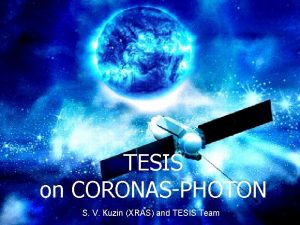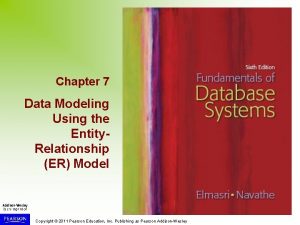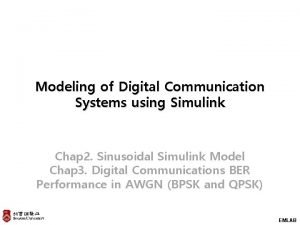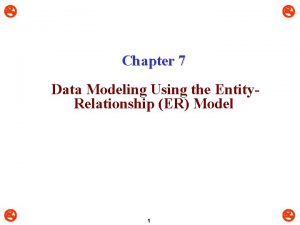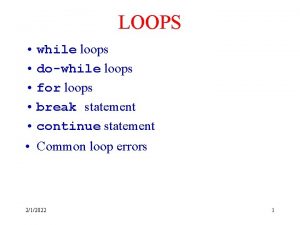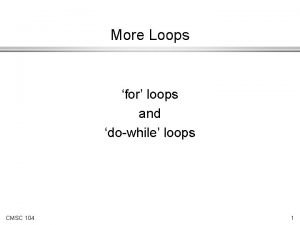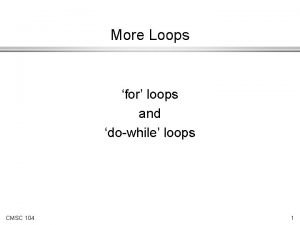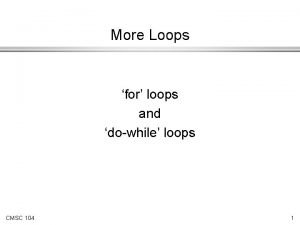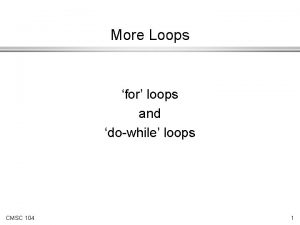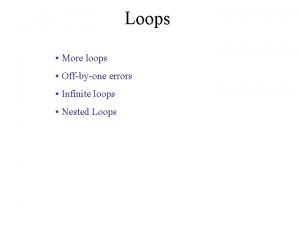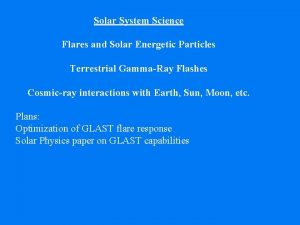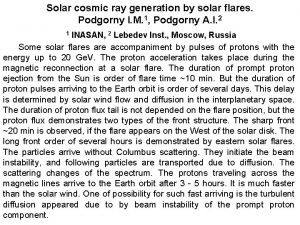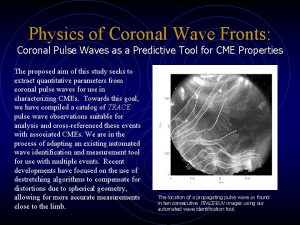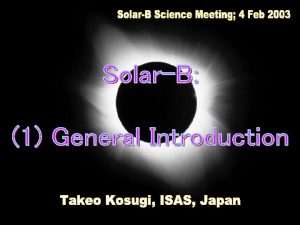Modeling Solar Flares Using Tapered Coronal Loops Natalie

















- Slides: 17

Modeling Solar Flares Using Tapered Coronal Loops Natalie Larson Dr. Kathy Reeves, Dr. Trae Winter Harvard Smithsonian Center for Astrophysics Solar Physics REU 2010

What is a solar flare? XRT TRACE

Closer view of solar flare http: //hesperia. gsfc. nasa. gov/sftheory/flareimage. htm http: //cse. ssl. berkeley. edu/segwayed/lessons/exploring_magnetism/in_Solar_Flares/s 4. html

The project: long-term goals Understand relationship between energy release and hard and soft X-rays Determine amount of energy input that produces particular hard and soft X-ray light curves by varying energy input into model Relationship between peak soft X-ray flux and total energy input Conditions under which Neupert Effect is seen

Neupert Effect 5 Dennis and Zarro, “The Neupert Effect, ” 1993

This summer: modeling tapered loops • Implications of modeling a flare with tapered loops: • More accurate representation of flare loop • Energy and density variations along the loop • Non-thermal particle mirroring

Kathy’s Model Based on Lin and Forbes Model • Input: Reconnection rate and magnetic field strength • Output: energy released and geometry of the loop

Trae’s Model: Hy. Loop • Hy. Loop: The controller • SHRe. C: Solar Hydrodynamic Equation Codes (thermal particles) • PATC: Particle Tracking Codes (non-thermal particles)

Method • Generate flare using Kathy’s model: multistranded loop model • Output Energy and Geometry • Put Energy and Geometry into my Heating Function • Output rate of energy input into given loop over loop length and over time • Trae’s model works with heating function to describe evolution of temperature and density in flare over time • Temperature and density output used by my GOES function to give GOES light curve

My contribution: Heating function

Geostationary Operational Environmental Satellite Text

My contribution: GOES flux +

Results: GOES light curve GOES flux function is more dependent on density than on temperature Tapered loops simulated in our experiment have lower GOES flux than non-tapered loops simulated last year

Results: temperature and density Density lower and temperature higher with tapered loops: GOES flux program depends much more on density than on temperature => GOES flux is lower with tapered loops

Conclusions • Need to have sufficiently thick chromosphere to accurately model flares • Shortage of chromosphere can lead to lower flare loop densities and higher flare loop temperatures

Future Work • Implement a thicker chromosphere • Try to approximate flare energy input by comparing simulated and actual light curves • Model flare in hard X-rays by using non-thermal particles • Examine circumstances that lead to Neupert Effect • Examine whether peak soft X-ray flux is proportional to total energy input when the Neupert Effect is exhibited

Thank you! • Kathy and Trae! • Cf. A: Solar Group • NSF
 Tesis solar flares
Tesis solar flares Counter bevel onlay
Counter bevel onlay Modeling and role modeling theory
Modeling and role modeling theory Dimensional modeling vs relational modeling
Dimensional modeling vs relational modeling It has 4 to 5 inches finely tapered blades
It has 4 to 5 inches finely tapered blades Taper integration
Taper integration Tapered iso chart
Tapered iso chart Tapered aeration process
Tapered aeration process Spinal cord anatomy
Spinal cord anatomy Whosale solar
Whosale solar What is an inexhaustible source of energy
What is an inexhaustible source of energy Modeling using variation calculator
Modeling using variation calculator Data modeling using entity relationship model
Data modeling using entity relationship model Lesson 12 modeling using similarity
Lesson 12 modeling using similarity Modeling of digital communication systems using simulink
Modeling of digital communication systems using simulink Modeling of digital communication systems using simulink
Modeling of digital communication systems using simulink Er diagram of a company
Er diagram of a company Planes in body
Planes in body
